

07311.14286.pdf. Is not available. Plans.pdf. Usher_et_al_tcgj_22_lammas_2013.pdf. Do you hear things after playing video games? There's a name for that. When you switch off a video game, a really involving and engrossing video game, sometimes it doesn’t go away.

Not straight away. Instead, it can linger in the mind, overlaying the real world. At least that’s according to new research from Nottingham Trent University’s International Gaming Research Unit. Recently published in the Journal of Cyber Behaviour, Psychology and Learning, it suggests that players often hear game sounds such as explosions, screams and laser fire, long after they’ve left a game.
This is the latest study into what the university calls “game transfer phenomena”, a range of cognitive quirks that can follow extended gaming sessions. For the study, the Nottingham Trent team visited games forums and collected anecdotal evidence from 1,244 gamers about GTP experiences. 12 per cent of those spoke of re-experiencing game audio outside of the game environment – hearing sword slashes, electronic beeps and Super Mario’s falling coin sound were all reported.
What's the secret to high scores on video games? By Siu-Lan Tan When playing video games, do you play better with the sound on or off?

Every gamer may have an opinion, but what has research shown? Some studies suggest that music and sound effects enhance performance. For instance, Tafalla (2007) found that male gamers scored almost twice as many points while playing the first-person shooter game DOOM with the sound on (chilling music, weaponfire, screams, and labored breathing) compared to those playing with the sound off. On the other hand, Yamada et al. (2001) found that people had the fastest lap times in the racing game Ridge Racer V when playing with the music off. Sometimes the results are more complex. How music affects your productivity. Inverse-Foley Animation: Synchronizing rigid-body motions to sound. Develop.scee.net/files/presentations/develop2010/AudioAnalysis,themissinglink.pdf. There Really Is a Conference Where Nerds Study Videogame Music. Bioshock Infinite’s barbershop quartet.
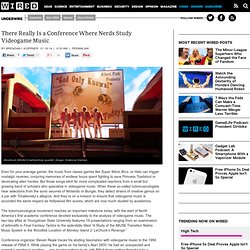
Image: Irrational Games Even for your average gamer, the music from classic games like Super Mario Bros. or Halo can trigger nostalgic reveries, conjuring memories of endless hours spent fighting to save Princess Toadstool or decimating alien hordes. But those songs elicit far more complicated reactions from a small but growing band of scholars who specialize in videogame music. When these so-called ludomusicologists hear selections from the sonic oeuvres of Nintendo or Bungie, they detect strains of creative genius on a par with Tchaikovsky’s allegros.
And they’re on a mission to ensure that videogame music is accorded the same respect as Hollywood film scores, which are now much studied by academics. The ludomusicological movement reaches an important milestone today, with the start of North America’s first academic conference devoted exclusively to the analysis of videogame music. Musicology professor to release book on video game music. Most avid video gamers would recognize the tune from “Super Mario Bros.,” the theme from “The Legend of Zelda” or the orchestration from “Final Fantasy.”

For assistant professor of musicology William Gibbons, however, video game music is far more than just background noise—it is an academic venture. Gibbons is a co-editor of the book “Music in Video Games: Studying Play,” which is set for release in February of next year, and will also teach a class on video game music during the 2014 fall semester.
“I’d like for us to be able to critically analyze what we’re consuming in games,” Gibbons said. “And it really changes our experience, I think, for the better, when we can think more analytically about what we’re experiencing and why we feel the way we do and how it affect us.” Precomputed Acceleration Noise for Improved Rigid-Body Sound. We introduce an efficient method for synthesizing acceleration noise - sound produced when an object experiences abrupt rigid-body acceleration due to collisions or other contact events.
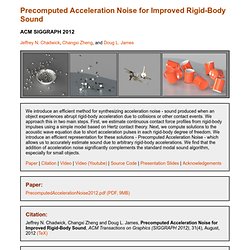
We approach this in two main steps. First, we estimate continuous contact force profiles from rigid-body impulses using a simple model based on Hertz contact theory. Next, we compute solutions to the acoustic wave equation due to short acceleration pulses in each rigid-body degree of freedom. Experiments in Aural Resistance: Nordic Role-Playing, Community, and Sound. Editor’s Note: Welcome to Sounding Out!

‘s fall series titled “Sound and Play,” where we ask how sound studies, as a discipline, can help us to think through several canonical perspectives on play. While Johan Huizinga had once argued that play is the primeval foundation from which all culture has sprung, it is important to ask where sound fits into this construction of culture; does it too have the potential to liberate or re-entrench our social worlds? How Many Mobile Users Play with Sound On? (73%)
I get asked this question a lot, so here are the facts.
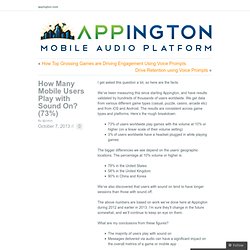
We’ve been measuring this since starting Appington, and have results validated by hundreds of thousands of users worldwide. We get data from various different game types (casual, puzzle, casino, arcade etc) and from iOS and Android. The results are consistent across game types and platforms. Here’s the rough breakdown: 73% of users worldwide play games with the volume at 10% or higher (on a linear scale of their volume setting)3% of users worldwide have a headset plugged in while playing games The bigger differences we see depend on the users’ geographic locations.
Touch & Activate: Adding Interactivity to Existing Objects using Active Acoustic Sensing (UIST2013) Interactive Music Theory. I found some theory about interactive, adaptive, nonlinear game music that hasn’t been posted on Captivating Sound yet.
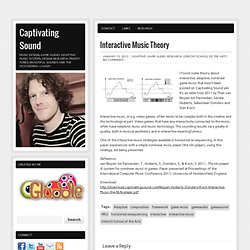
It’s an oldie from 2011 by Than van Nispen tot Pannerden, Sander Huiberts, Sebastiaan Donders and Stan Koch. Interactive music, in e.g. video games, often tends to be complex both in the creative and the technological part. Video games, that have any interactivity connected to the music, often have simplistic music and music technology. The sounding results vary greatly in quality, both in musical aesthetics and in interactive meaningfulness. One of the interactive music strategies available is horizontal re-sequencing. Soda.swedish-ict.se/4048/1/Game_Sound_Experience.pdf. Limited - Physical Responses to Audio In Games. Euphonious commissions independent study on the effect of audio in games 18th April 2012 Physical responses (arousal) to audio in games for Euphonious(Produced by Robertson, P & Sloan, R.J.S.
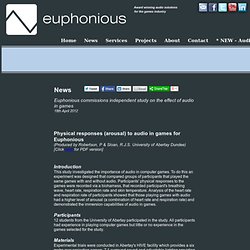
University of Abertay Dundee) [Click here for PDF version] IntroductionThis study investigated the importance of audio in computer games. To do this an experiment was designed that compared groups of participants that played the same games with and without audio. Participants' physical responses to the games were recorded via a bioharness, that recorded participant's breathing wave, heart rate, respiration rate and skin temperature.